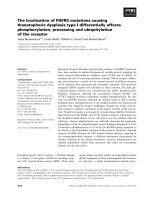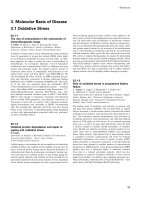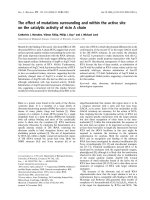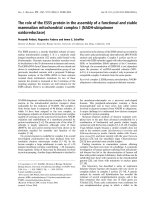Báo cáo khoa học: "The Parameters of Conversational Style" ppt
Bạn đang xem bản rút gọn của tài liệu. Xem và tải ngay bản đầy đủ của tài liệu tại đây (203.27 KB, 2 trang )
The Parameters of Conversational Style
Deborah Tannen
Georgetown University
There are several dimensions along which verbalization
responds to context, resulting in individual and social
differences in conversational style. Style, as I use
the term, is not something extra added on, like decora-
tion. Anything that is said must be said in some way;
co-occurrence expectations of that "way" constitute
style. The dimensions of style I will discuss are:
I. Fixity vs. novelty
2. Cohesiveness vs. expressiveness
3. Focus on content vs. interpersonal involvement.
Fixity vs. novelty
Any utterance or sequence must be identified (rightly or
wrongly, in terms of interlocuter's intentions) with a
recognizable frame, as it conforms more or less to a
familiar pattern. Every utterance and interaction is
formulaic, or conventionalized, to some degree. There
is a continuum of formulaicness from utterly fixed
strings of words (situational formulas: "Happy birth-
day," "Welcome home," "Gezundheit") and strings of
events (rituals), to new ideas and acts put together in
a new way. Of course, the latter does not exist except
as an idealization. Even the most novel utterance is to
some extent formulaic, as it must use familiar words
(witness the absurdity of Humpty Dumpty's assertion that
when he uses a word it means whatever he wants it to
mean, and notice that he chooses to exercise this li-
cense with only one word); syntax (again Lewis Carroll
is instructive: the "comprehensibility" of Jabberwocky);
intonation; coherence principles (cf Alton Becker); and
content (Mills' "vocabularies of motives," e.g.). All
these are limited by social convention. Familiarity
with the patterns is necessary for the signalling of
meaning both as prescribed and agreed upon, and as cued
by departure from the pattern (cf Hymes).
For example, a situational formula is a handy way to
signal familiar meaning, but if the formula is not known
the meaning may be lost entirely, as when a Greek says
to an American cook, "Health to your hands." If mean-
ing is not entirely lost, at least a level of resonance
is lost, when reference is implicit to a fixed pattern
which is unfamiliar to the interlocutor. For example,
when living in Greece and discussing the merits of buy-
ing an icebox with a Greek Friend, I asked, "Doesn't the
iceman cometh?" After giggling alone in the face of his
puzzled look, I ended up feeling I hadn't communicated
at all. Indeed I hadn't.
Cohesiveness vs. expressiveness
This is the basic linguistic concept of markedness and
is in a sense another facet of the above distinction.
What is prescribed by the pattern for a given context,
and what is furnished by the speaker for this instance?
To what extent is language being used to signal "busi-
ness as usual," as opposed to signalling, "Hey, look at
this!" This distinction shows up on every level of
verbalization too: lexical choice, pitch and amplitude,
prosody, content, genre, and so on. For example, if
someone uses an expletive, is this a sign of intense
anger or is it her/his usual way of talking? If they
reveal a personal experience or feeling, is that evi-
dence that you are a special friend, or do they talk
that way to everybody? Is overlap a way of trying to
take the floor away from you or is it their way of
showing interest in what you're saying? Of course, ways
of signalling special meaning expressiveness are
also prescribed by cultural convention, as the work of
John Gumperz shows. The need to distinguish between
individual and social differences is thus intertwined
with the need to distinguish between cohesive and ex-
pressive intentions. One more example will be presented,
based on spontaneous conversation taped during Thanks- •
giving dinner, among native speakers of English from
different ethnic and geographic backgrounds.
In responding to stories and comments told by speakers
from Los Angeles of Anglican/Irish background, speakers
of New York Jewish background often uttered paralinguis-
tically gross sounds and phrases ("WHAT!? How INTer-
esting! You're KIDding! Ewwwwww!"). In this con-
text, these "exaggerated" responses had the effect of
stopping conversational flow. In contrast, when similar
responses were uttered while listening to stories and
comments by speakers of similar background, they had the
effect of greasing the conversational wheels, encourag-
ing conversation. Based on the rhythm and content of
the speakers' talk, as well as their discussion during
playback (i.e. listening to the tape afterwards), I
could hypothesize that for the New Yorkers such "ex-
pressive" responses are considered business as usual; an
enthusiasm constraint is operating, whereby a certain
amount of expressiveness is expected to show interest.
It is a cohesive device, a conventionally accepted way
of having conversation. In contrast, such responses
were unexpected to the Californians and therefore were
taken by them to signal, "Hold it! There's something
wrong here." Consequently, they stopped and waited to
find out what was wrong. Of course such differences
have interesting implications for the ongoing interac-
tion, but what is at issue here is the contrast between
the cohesive and expressive use of the feature.
Focus on content vs. interpersonal involvement
Any utterance is at the same time a statementof content
(Bateson's 'message') and a statement about the rela-
tionship between interlocutors ('metamessage'). In
other words, there is what I am saying, but also what it
means that I am saying this in this way to this person
at this time. In interaction, talk can recognize, more
or less explicitly and more or less emphatically (these
are different), the involvement between interlocutors.
It has been suggested that the notion that meaning can
stand alone, that only content is going on, is associa-
ted with literacy, with printed text. But certainly
relative focus on content or on interpersonal involve-
ment can be found in either written or spoken Form. I
suspect, for example, that one of the reasons many people
find interaction at scholarly conferences difficult and
stressful is the conventional recognition of only the
content level, whereas in fact there is a lot of involve-
merit among people and between the people and the content.
Whereas the asking of a question following a paper is
conventionally a matter of exchange of information, in
fact it is also a matter of presentation of self, as
Goffman has demonstrated for all forms of behavior.
A reverse, phenomenon has been articulated by Gall Drey-
fuss. The reason many people feel uncomfortable, if not
scornful, about encounter group talk and "psychobabble"
is that it makes explicit information about relation-
ships which people are used to signalling on the meta
level.
Relative focus on content gives rise to what Kay (1977)
calls "autonomous" language, wherein maximal meaning is
encoded lexically, as opposed to signalling it through
use of paralinguistic and nonlinguistic channels, and
wherein maximal background information is furnished, as
opposed to assuming it is already known as a consequence
of sharedexperience. Of course this is an idealization
as well, as no meaning at all could be communicated if
39
there were no common experience, as Fillmore (197g)
amply demonstrates. It ~s crucial, then, to know the
operative conventions. As much of my own early work
shows, a hint {i.e. indirect communication) can be miss-
ed if a listener is unaware that the speaker defines the
context as one in which hints are appropriate. What is
intended as relatively direct communication can be ta-
ken to mean f r more, or simply other, than what is
meanS if the listener is unaware that the speaker de-
fines the context as one'in which hints are inappropri-
ate. A common example seems to be communication between
intimates in which one partner, typically the female,
assumes, "We know each other so well that you will know
what I mean without my saying it outright; all I need do
is hint"; while the other partner, typically the male,
assumes, "We know each other so well that you will tell
me what you want."
Furthermore, there are various ways of honoring inter-
~ersonal involvement, as service of two overriding hu-
man goals. These have been called, by Brown and Levin-
son (1978}, positive and negative politeness, building
on R. Lakoff's stylistic continuum from camaraderie to
distance (1973) and Goffman's presentational and avoid-
ance rituals (1967). These and other schemata recog-
nize the universal human needs to l) be connected to
other people and 2) be left alone. Put another way,
there are universal, simultaneous, and conflicting hu-
man needs for community and independence.
Linguistic choices reflect service of one or the other
of these needs in various ways. The paralinguistically
gross listener responses mentioned above are features in
an array of devices which I have hypothesized place the
signalling load (Gumperz' term) on the need for commu-
nity. Other features co-occurring in the speech of many
speakers of this style include fast rate of speech; fast
turn-taking; preference for simultaneous speech; ten-
dency to introduce new topics without testing the con-
versational waters through hesitation and other signals;
persistence in introducing topics not picked up by oth-
ers; storytelling; preference for stories told about
personal experience and revealing emotional reaction of
teller;'talk about personal matters; overstatement for
effect. (All of these features surfaced in the setting
of a casual conversation at dinner; it would be pre-
mature to generalize for other settings). These and
other features of the speech of the New Yorkers some-
times struck the Californians present as imposing, hence
failing to honor their need for independence. The use
of contrasting devices by the Californians led to the
impression on some of the New Yorkers that they were
deficient in honoring the need for community. Of course
the underlying goals were not conceptualized by partici-
pants at the time. What was perceived was sensed as
personality characteristics: "They're dominating," and
"They're cold." Conversely, when style was shared, the
conclusion was, "They're nice."
Perhaps many of these stylistic differences come down to
differing attitudes toward silence. I suggest that the
fast-talking style I have characterized above grows out
of a desire to avoid silence, which has a negative value.
Put another way, the unmarked meaning of silence, in
this system, is evidence of lack of rapport. To other
speakers for example, Athabaskan Indians, according
to Basso (1972) and Scollon (1980) the unmarked mean-
ing of silence is positive.
Individual and social differences
All of these parameters are intended to suggest pro-
cesses that operate in signalling meaning in conversa-
tion. Analys'is of cross-cultural differences is useful
to make apparent processes that go unnoticed when sig-
nalling systems are shared.
An obvious question, one that has been indirectly
addressed throughout the present discussion, confronts
the distinction between individual and cultural differ-
ences. We need to know, for the understanding of our
own lives as much as for our theoretical understanding
of discourse, how much of any speaker's style the
linguistic and paralinguistic devices signal)ing meaning
are prescribed by the culture, and which are chosen
freely. The answer to this seems to resemble, one level
further removed, the distinction between cohesive vs.
expressive features. The answer, furthermore, must lie
somewhere between fixity and novelty a matter of
choices among alternatives offered by cultural convention.
References
Basso, K. 1972. To give up on words: Silence in Western
Apache culture, in P.P. Giglioli, ed., Language in
social context. Penguin.
Brown, P. & S. Levinson. 1978. Universals in language
usage: Politeness phenomena, in E. Goody, ed., Ques-
tions and politeness. Cambridge.
Fillmore, C. 1979. Innocence: A second idealization for
linguistics, Proceedings of the fifth annual meeting
of the Berkeley Linguistics Society.
Goffmen, E. 1967. Interaction rttual. Doubleday.
Kay, P. 1977. Language evolution and speech style, in B.
Blount & M. Sanches, eds., Sociocultural dimensions of
language change. NY: Academic.
Lakoff, R. 1973. The logic of politeness, or minding
your p's and q's. Papers from the ninth regional
meeting of the Chicago Linguistics Society.
Scollon, R. 1980. The machine stops: Silence in the
metaphor of malfunction. Paper prepared for the A~er-
ican Anthropological Association annual meeting.
40
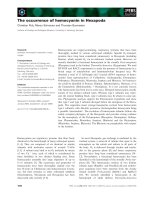

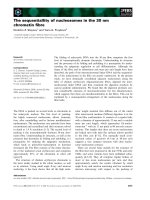
![Tài liệu Báo cáo khoa học: The stereochemistry of benzo[a]pyrene-2¢-deoxyguanosine adducts affects DNA methylation by SssI and HhaI DNA methyltransferases pptx](https://media.store123doc.com/images/document/14/br/gc/medium_Y97X8XlBli.jpg)
